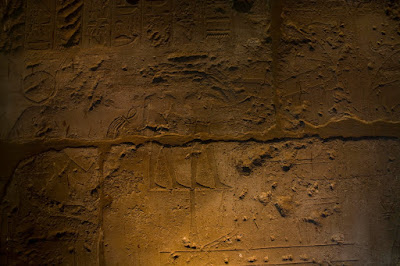We now return to the Hypostyle Hall, in order to get access, by passing
out of the temple, and re-entering it on the right hand, beyond the First
Vestibule, to the Birth-room, which as we have seen, was at least one of the
reasons for the building of the whole temple .
Originally the roof of the chamber was supported by three clustered
columns ; but these and the roof have collapsed .
The reliefs on the west wall are the ones which present to us the
figment of the king's divine filiation . There are three rows of scenes .
the
story beginning at the north end of the lowest row . Here we see first the god
Khnûm ( the creator-god ) moulding on the potter's wheel two children, who are
to be Amenhotep and his Ka ( the Ka or Vital Spark or Life Force was the
Egyptian concept of vital essence, that which distinguishes the difference
between a living and a dead person, with death occurring when the ka left the
body . The Egyptians believed that Khnûm created the bodies of children on a
potter's wheel and inserted them into their mothers' bodies . Depending on the
region, Egyptians believed that Heket or Meskhenet was the creator of each
person's Ka, breathing it into them at the instant of their birth as the part
of their soul that made them be alive . This resembles the concept of spirit in
other religions ).
Isis watches the performance . We then see Queen
Mutemwia, Amenhotep's mother, being embraced by Isis in the presence of Amûn,
who falls in love with her . Amûn is then led by Thoth, the ibis-headed god of
wisdom, into the queen's chamber, where he is to take the place of the absent
Tuthmosis IV . Next we see Amûn and the queen seated together on the symbol for
heaven, and supported by the goddesses Selqet ( The Scorpion Goddess of Egypt,
the goddess of fertility )
and Neith ( goddess of war and weaving ) . Amûn puts the breath of life into
the queen's nostrils, and, before leaving her, reveals himself as divine, and intimates
to Mutemwia that the child who shall be born of their union shall be named Amenhotep
.
Amûn then gives due instructions to Khnûm, the
creator-god, who has the task of moulding mankind on his potter's wheel ; and
we next see Khnûm busily modeling two little figures, one of the
king-to-be-himself, the other of his Ka . Isis watches the work, and gives life to the
figures .
We
now turn to the middle row, where the figures run in the south-north direction
. First, Thoth announces to Mutemwia the approach of her confinement . The
queen is led to her chamber, where she is seated upon a stool, while Isis and
Khnûm chafe her hands . Bes and Thouêris, the patrons of childbirth, together
with other genii, are present . Isis next presents the newly-born child to Amûn
his father ; and Amûn dandles his son in his arms, in the presence of Hathor
and Mût . The topmost row shows the nursing of the child by goddesses, including
the nine Hathors ( the fairy godmothers of Egypt ) ; while the last scene shows
him as a grown man and Pharaoh . The other reliefs in the room show Amenhotep
being blessed by various gods .
Part ( 7 ) Coming SoOoOon .....
Uploading .....








No comments:
Post a Comment